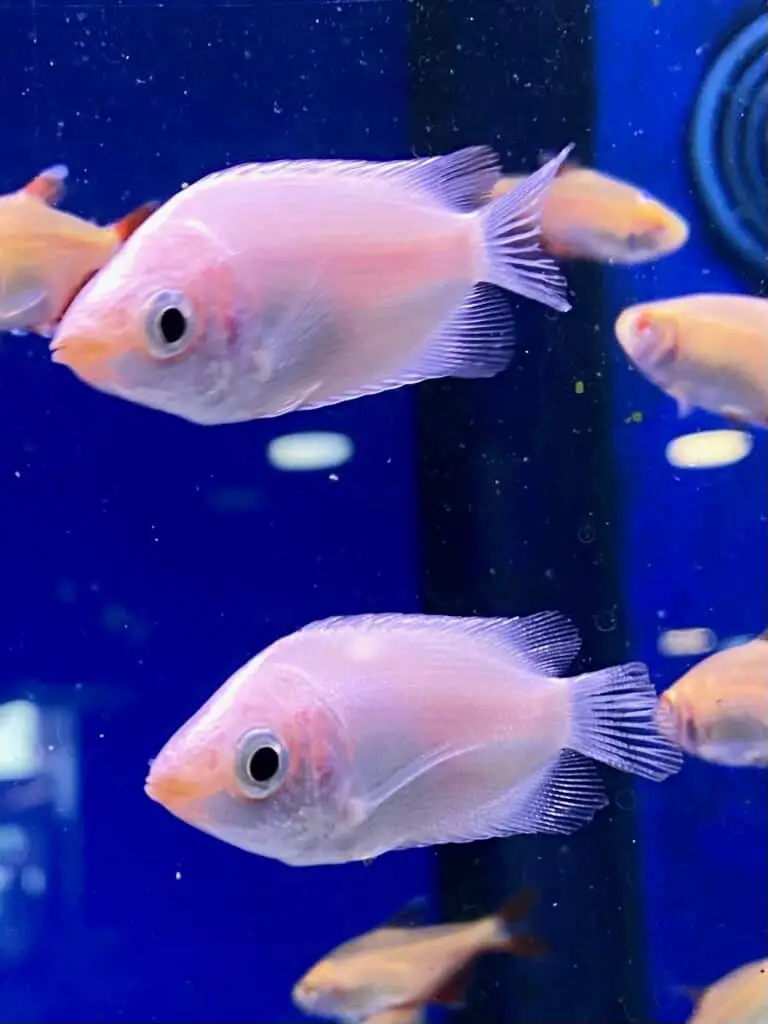Gouramis are close cousins of Siamese fighting fish, and they need aquarium conditions that mimic their natural freshwater environment as closely as possible. Dwarf and pearl gourami are territorial and solitary like betta—another name for Siamese fighting fish—and hail from the calm tropical rivers of Asia.
Gouramis do not like current in their aquarium environment because they are used to rivers and bodies of water that move very slowly and are shallow. These environments are oxygen-poor and almost stagnant.
Let’s explore gouramis’ natural habitat and what you can do to replicate such a low-current Eden for your gouramis. I’ll also explain how to identify stressors in a fish tank.
Why Gouramis Don’t Like Current.

Gouramis do not like current because their natural environment includes the swamps, wetlands, and marshes of South-East Asia. Gouramis’ sluggish riverine habitats range from Pakistan to Korea.
Natural Habitat for Gouramis.
In the wild, gouramis are primarily found in sluggish, shallow bodies of water with low oxygen levels.
They have adapted very well to this type of environment because of their labyrinth organ. This specialised organ allows gouramis or labyrinth fish to absorb oxygen from the air.
One of the first labyrinth fish to be introduced to aquarium hobbyists outside their native South-East Asia is the paradise gourami.
Despite its name, the paradise gourami is one of the most aggressive members of this species. These predators range from the marshes of the Korean peninsula to the Northern rice paddies of Vietnam.
Ideal temperature ranges for gouramis are between 22°C and 27°C (72°F and 82°F). While gouramis are hardy, avoid temperature fluctuations to protect their labyrinth organ.
The water should be neutral, but gourami may tolerate a slightly acidic tank with a pH between 6 and 8. This scale describes the potential hydrogen present in the water.
Try to maintain the water hardness between 4 and 15 degrees of General Hardness (GH). GH refers to how much magnesium and calcium is in the water.
How to Recreate a Natural Habitat for Gouramis.
Let’s find out how you can recreate a beautiful, natural habitat for your first gourami.
Use a tank that can hold at least 50 litres (12 gallons) of water, such as the Diversa Aquarium Professional Fish Tank (available on Amazon.com). This tank is made with original Guardian glass, which is exceptionally resistant and transparent.
Gouramis spend a lot of time at the surface, so tall plants are an excellent way to encourage them to swim up. Free-floating aquarium plants also add to the authenticity of the aquarium.
Free-floating plants that are sure to be a hit with your gourami include the Amazon frogbit, the hornwort, and the Java fern.
Add rocks, driftwood, decor, and gravel to provide enough hiding places and break up any strong water currents.
If you need some inspiration, take a look at MD Fish Tanks’ Aquascape tutorial:
What Can Cause a Current in a Fish Tank?
The filter can cause a current in a fish tank when it is too powerful or too large for the tank it’s placed in. It is recommended to choose smaller tanks for keeping your gourami healthy and happy.
If your aquarium’s filter current is too strong, your gourami may struggle to swim and forage for food. It might become anxious and exhibit signs of stress.
How To Tell if a Gourami Is Stressed.
One of the first signs that your gourami is stressed is its lack of appetite. Stressed fish generally do not eat. In this case, your gourami might be struggling to swim. It may be restricting its movement to avoid the strong water flow and becoming weak from hunger.
In this weakened state, your gourami will hide for long periods. When you do catch a glimpse, your gourami may be swimming in unusual patterns.
The company your gourami keeps may also cause him stress. Gouramis are solitary fish, and you should not keep more than one in the same tank.
Even a 55-gallon (208.2-liter) tank is not large enough for three gouramis, as you can see in this video:
Look out for any signs of stress from your gourami when you introduce the new tank mates. Because gouramis are territorial, they may get aggressive and attack the other surface-dwelling fish, such as guppies.
Cory Catfish (Corydoras) make ideal tank mates because they enjoy similar aquatic environments to gouramis and are bottom-dwellers.
How To Reduce a Strong Current in a Fish Tank.
The first thing you can do to reduce the strong current in your fish tank is to locate the flow adjustor of the aquarium filter.
The filter may be too powerful for your gourami’s tank. A power filter is not appropriate for a 10- to 30-gallon (37.85 to 113.5-liter) gourami aquarium. Try installing a simpler sponge filter with an air pump that can be adjusted for a gentler flow.
You can block the input with a sponge light enough that it doesn’t restrict the pump or prevents it from working correctly.
You can also block the output with a filter baffle to slow the current. Here is a video showing you how to make a baffle using simple materials:
Another simple trick to reduce the water flow is to disperse the outflow toward the back wall of the fish tank or toward the surface of the water.
Finally, place some live plants underneath the outflow pipe to break up the water current as it enters the fish tank.
Conclusion.

Gouramis are popular with many first-time aquarium hobbyists. Setting up a basic tank that meets your gourami’s needs is simple and does not require much maintenance.
It’s essential that you maintain a gentle current to avoid stressing your gourami. Happy gourami can live anywhere between five and seven years in the wild!


